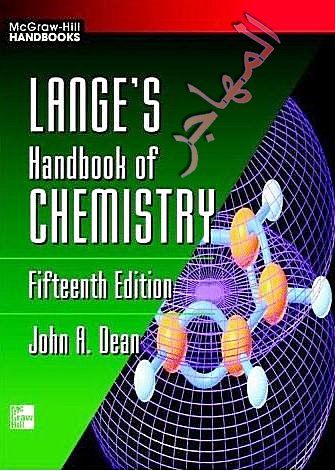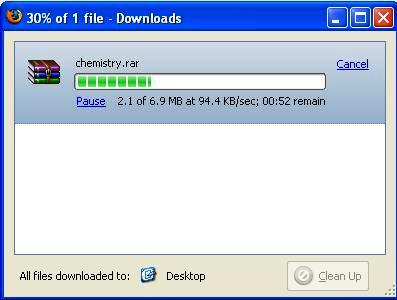
Lange's Handbook Of Chemistry

Product Details
* 1292 pages ((( PDF))) 6.9 mb
* Publisher: McGraw-Hill Professional; 15 edition (October 30, 1998)
* Language: English
* ISBN-10: 0070163847
* ISBN-13: 978-0070163843
* Publisher: McGraw-Hill Professional; 15 edition (October 30, 1998)
* Language: English
* ISBN-10: 0070163847
* ISBN-13: 978-0070163843
A major revision of the handbook that chemists rely on for fast, accurate information in every area of chemistry. Table of Contents: Organic Chemistry; General Information, Conversion Tables And Mathematics; Inorganic Chemistry; Properties of Atoms; Radicals and Bonds; Physical Properties; Thermodynamic Properties; Spectroscopy; Electrolytes; Electromotive Force and Chemical Equilibrium; Physiochemical Relationships; Polymers; Rubbers; Fats, Oils and Waxes; Practical Laboratory Information.
The handbook every chemist must have.
Reviewer:
A reader
The NST/Engineers, Inc. reviewers have relied on the prior editions of this classic handbook for decades. We believe this 1999 fifteenth edition of Lange to be a close-at-hand, bookshelf necessity for science students, chemists, chemical engineers, and for others whose sphere of interest intersects with that of chemistry. Every industrial library and most general interest libraries should have a copy. For those unfamiliar with Lange, it serves as a first reference for questions dealing with "chemicals". Rather than chemicals we should refer to elements, molecular compounds, radicals, and mixtures of compounds, among other definitions of matter. (The properties of water, a molecular compound, are well covered in the book.) If you have been using a copy of the thirteenth edition, or earlier, you should upgrade now to this fifteenth edition. Division of the handbook contents into eleven major sections helps in searches. Lange Sections 1 and 3 are probably used most frequently to find densities, melting and boiling points, and solubilities in various solvents of organic and inorganic compounds. For the organic compounds, at the foot of the data page, alternate names are listed. Also there, structural formulas show details of the more complicated structures. For those who need in-depth information on any listed compound, the Beilstein reference is also given. There is an "Empirical Formula Index of Organic Compounds". Thus if you know the number of carbon, hydrogen, and other atoms in a compound's formula, you can readily find the properties of the one compound or a few specific compounds that match that formula.
The NST/Engineers, Inc. reviewers have relied on the prior editions of this classic handbook for decades. We believe this 1999 fifteenth edition of Lange to be a close-at-hand, bookshelf necessity for science students, chemists, chemical engineers, and for others whose sphere of interest intersects with that of chemistry. Every industrial library and most general interest libraries should have a copy. For those unfamiliar with Lange, it serves as a first reference for questions dealing with "chemicals". Rather than chemicals we should refer to elements, molecular compounds, radicals, and mixtures of compounds, among other definitions of matter. (The properties of water, a molecular compound, are well covered in the book.) If you have been using a copy of the thirteenth edition, or earlier, you should upgrade now to this fifteenth edition. Division of the handbook contents into eleven major sections helps in searches. Lange Sections 1 and 3 are probably used most frequently to find densities, melting and boiling points, and solubilities in various solvents of organic and inorganic compounds. For the organic compounds, at the foot of the data page, alternate names are listed. Also there, structural formulas show details of the more complicated structures. For those who need in-depth information on any listed compound, the Beilstein reference is also given. There is an "Empirical Formula Index of Organic Compounds". Thus if you know the number of carbon, hydrogen, and other atoms in a compound's formula, you can readily find the properties of the one compound or a few specific compounds that match that formula.
Section 2, "General Information, Conversion Tables, and Mathematics", is worthy of review by all who want to know where to find the recommended symbols, latest definitions, and SI (international or metric system) values for chemical and physical properties. For those of us still steeped in British and U.S. unit usage, there are conversion factors to and from just about any unit of interest. Section 4, "Properties of Atoms, Radicals, and Bonds", gives the electronic configuration and properties of the elements, bond lengths, radii, dissociation energies, a table of nuclides, and much more. Section 5 on "Physical Properties" goes into many other properties than the earlier organic and inorganic sections. Vapor pressure, viscosity, surface tension, and a host of other properties, are listed for the more widely used compounds and their solutions.
Section 6, "Thermodynamic Properties", begins with an introductory explanation of enthalpy and entropy changes and heat capacity. Explanation of Gibbs energies is missing. However, all four of these properties are then listed for organic and inorganic compounds. Critical properties are also given. There are 138 pages of data together with some spectrometric property explanations in Section 7, "Spectroscopy".
The 168 page Section 8, "Electrolytes, EMF, and Chemical Equilibrium" covers those topics and then even includes standards for pH measurement of blood and biological media. In an in-depth, October 1999 paper on electrolytes in Chemical Engineering Progress, Lange was the only broad-coverage handbook cited among 56 references.
Section 9, "Physicochemical Relationships", gives a brief description of linear free energy relationships and the Hammett equation and the Taft equation. There is a table of Hammett and Taft Substituent Constants, and other tables with constants for the two equations. Section 10, "Polymers, Rubbers, Fats, Oils, and Waxes", contains, in addition to 67 pages of data, a good bit of descriptive information about the relationship between polymeric structure, functional groups, and the values of a polymer's mechanical and physical properties.
The closing 150 page Section 11, "Practical Laboratory Information", covers cooling and heating baths; drying and humidification compounds and mixtures; chromatography; gravimetric and volumetric analyses; and thermometry and thermocouples. Those frequent users of past Lange editions, and new users, will not be disappointed with this 15th edition.
http://ifile.it/0srfw3
or
http://ifile.it/ngsuedt
RAR archive password: twilightzone
or
http://rapidshare.de/files/22584948..._of_Chemistry__15th_Ed__McGraw_Hill_1999_.rar



